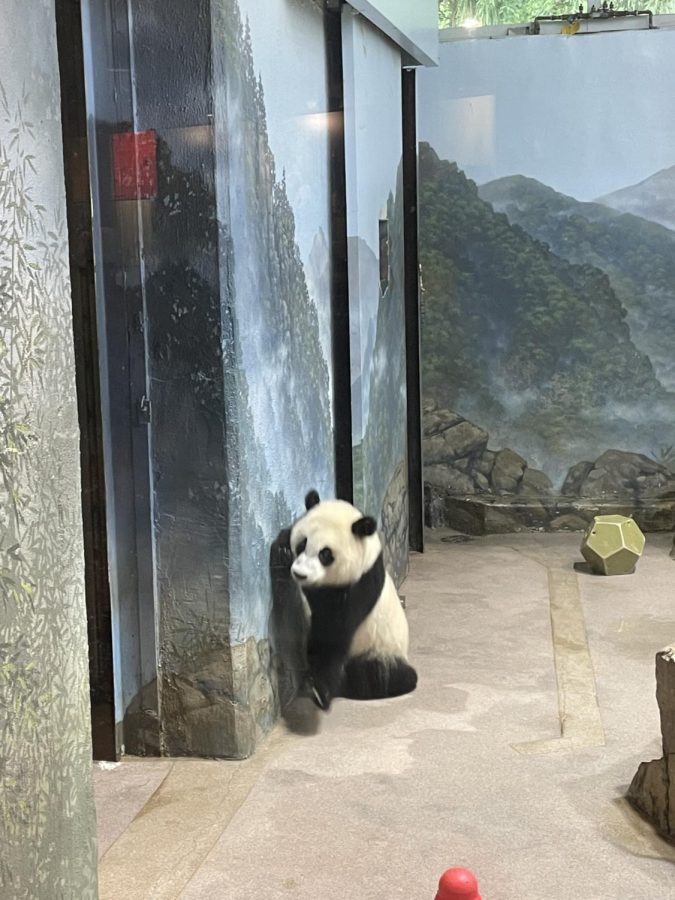Happy National Panda Day!
Photo courtesy of Jensen Kugler
The Smithsonian National Zoo in D.C. is home to three pandas: two adult pandas, Mei Xiang and Tian Tian, and one panda cub, Xiao Qi Ji (pictured).
National Panda Day is the day before St. Patrick’s Day each year, March 16th. Here are 16 facts about pandas to celebrate!
- Pandas do not only eat bamboo. A panda bear’s diet consists mainly of bamboo, leading many people to believe they are vegetarians. This is mainly true. However, pandas also consume small fish, insects, and meat. These foods make up only 1% of a panda’s diet, but pandas are still technically omnivores.
- The bears have lived on this planet for at least 600,000 years. Fossil evidence discovered in central and southern China suggests that they have existed since the middle of the Pleistocene Era. Indeed, pandas may not have always had their own national holiday, but they have been on this planet for a very long time.
- Pandas were not known outside China until the 20th century. The very first panda to leave China, Su-Lin, left in 1936. He lived in the Brookfield Zoo in Chicago during his time in America.
- They have no natural predators. Adult pandas grow to be so big that it is hard for other animals to attack them. However, snow leopards have been known to hunt panda cubs and sick adult bears.
- Pandas and red pandas are not closely related. Though both kinds of mammals are native to China and eat a ton of bamboo, they belong to different families of animals.
- In China, pandas hold many different symbolic meanings. Pandas are considered indicative of peace and friendship in China. Their black and white coloring is also seen as a physical representation of Yin and Yang, and they are thought to have the power to combat dark spirits.
- Pandas are no longer endangered. Due to the efforts of conservationists worldwide, pandas were removed from the endangered classification and were recategorized as a vulnerable species.
- In zoos, pandas live for approximately ten more years. Scientists estimate that pandas live 15-20 years in the wild and around 30 in human care.
- According to Chinese legend, pandas used to be all-white bears. In this story, a small girl tried to save a panda cub from being attacked and killed by a leopard. The leopard ended up killing the girl instead. Pandas came to her funeral and wore armbands of ashes. They hugged each other in sadness, wiped their eyes, covered their ears, and smudged the black ashes all over.
- Panda mothers are nine-hundred times the size of their newborn cub. To put this in perspective, an eight-pound human newborn would have a mother weighing 7,200 pounds.
- They spend over half of the day eating. Pandas eat bamboo for 10-16 hours every day.
- Pandas’ jaws are more powerful than an axe. Though the giant panda’s round fuzzy face may look chubby, its jaws are wide and powerful. Bamboo is hard to chop with an axe, but pandas can eat it with ease, in about 40 seconds, no less.
- They are expensive. Elephants cost a lot of money to keep in zoos, but pandas cost five times as much!
- Researchers dress as pandas. When studying pandas, researchers try to cause the least amount of stress possible to the bears. That is why they are often seen in full-body panda costumes when interacting with these animals.
- The World Wildlife Fund (WWF) chose the panda as their logo because it was cheaper. Though the giant panda’s endangered status at the time was one reason, another reason the WWF (World Wildlife Fund) chose to use the panda as their logo is because its black and white colors cost less to print.
- Their eyes differ from other bears. Panda eyes are more similar to those of domestic cats than other types of bears. They have vertical slits for their pupils.











